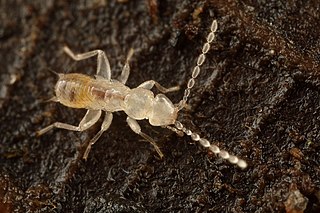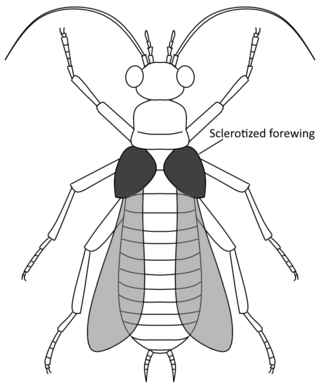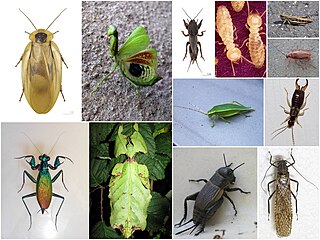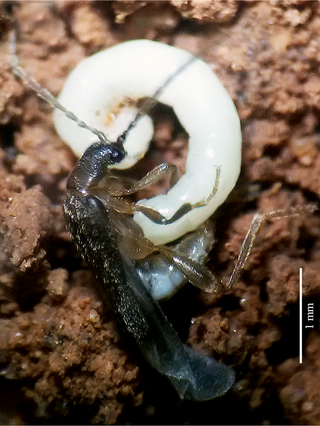
The insect order Zoraptera, commonly known as angel insects, contains small and soft bodied insects with two forms: winged with wings sheddable as in termites, dark and with eyes (compound) and ocelli (simple); or wingless, pale and without eyes or ocelli. They have a characteristic nine-segmented beaded (moniliform) antenna. They have mouthparts adapted for chewing and are mostly found under bark, in dry wood or in leaf litter.

Zorotypus is a genus of angel insects in the family Zorotypidae.

Byrrhoidea is a superfamily of beetles belonging to Elateriformia that includes several families which are either aquatic or associated with a semi-aquatic habitat. Other than the superfamily Hydrophiloidea, most of the remaining Polyphagan beetles which are aquatic are in this superfamily.
Selasia is a genus of beetles belonging to the family Elateridae, having historically been placed in the family "Drilidae", which was recently subsumed by Elateridae.

Nosodendridae is a family of beetles, with less than a hundred species in three extant genera, which are found worldwide. Nosodendron, the largest genus, is found in forests and attracted to yeast generated slime on the wounds of trees, and likely consumes fermented substances as well as fungi and microorganisms. Several additional genera and species are known from the fossil record. Nosodendridae is considered to be an isolated lineage within Polyphaga, being the sister group to the clade containing Staphyliniformia, Bostrichoidea and Cucujiformia.
Spiralizoros silvestrii is a species of angel insect in the family Zorotypidae. It is found in Southern Asia.

Rhinorhipus is a genus of beetles that contains a single species, Rhinorhipus tamborinensis from southern Queensland, Australia. It is the sole member of the family Rhinorhipidae and superfamily Rhinorhipoidea. It is an isolated lineage not closely related to any other living beetle, estimated to have split from other beetles at least 200 million years ago, with studies either considering them the earliest diverging member of Elateriformia, or a basal lineage within Polyphaga. They exhibit feigning death (thanatosis) when disturbed. Their ecology is poorly known. It is likely that they are fossorial based on their morphology.
Spermozoros impolitus is a species of insect in the order Zoraptera.

Gryllacridinae is an Orthopteran subfamily in the family Gryllacrididae.
Zorotypus absonus is an extinct species of insect in the order Zoraptera that lived during the Burdigalian age of the Miocene epoch. It was described from a fossil of an alate male found in Dominican amber; the specimen is deposited in Joachim Scheven's private collection at his "Lebendige Vorwelt" museum in Hagen, Germany.
Spiralizoros cervicornis is a species of insect in the order Zoraptera. It was first found in Malaysia.
Spiralizoros magnicaudelli is a species of insect in the order Zoraptera. It was first found in Malaysia.

Agraeciini is a large tribe of bush crickets or katydids in the conehead subfamily, Conocephalinae.

Alienopteridae is an extinct family of dictyopterans, known from the Mid-Cretaceous to Eocene. They are noted for their unusual combination of features not found in other dictyopterans.

The cohort Polyneoptera is one of the major groups of winged insects, comprising the Orthoptera and all other neopteran insects believed to be more closely related to Orthoptera than to any other insect orders. They were formerly grouped together with the Palaeoptera and Paraneoptera as the Hemimetabola or Exopterygota on the grounds that they have no metamorphosis, the wings gradually developing externally throughout the nymphal stages. Many members of the group have leathery forewings (tegmina) and hindwings with an enlarged anal field (vannus).
Zorotypus amazonensis is a species of insect in the genus Zorotypus. It is found in the Amazon, in the Brazilan state of Amazonas. Males possess features that distinguish them from related species. The male cerci is elongated, curved, and studded with three stiff setae along inner margins allowing for a "clasperlike" appearance.

Usazoros hubbardi, commonly known as Hubbard's angel insect, is a species of insect in the order Zoraptera. It is native to the tropical and subtropical New World and has expanded its range into the eastern United States, where it lives in piles of sawdust, whereas in the hotter part of its range it lives under the bark of decomposing logs. It was named after the American entomologist Henry Guernsey Hubbard, who discovered the insect in the United States.

Jurasaidae is a family of elateroid beetles known from around a half-dozen species in two genera found the Brazilian Atlantic rainforest including drier transitional areas bordering the Caatinga. All known species have neotenic larva-like females and normal males, similar to some other elateroids. They occur in the soil horizon immediately under leaf litter, with the larvae likely being fungivorous, consuming the fluids of fungal hyphae.
Spermozoros is a genus of angel insects in the family Zorotypidae. There are six described species in Spermozoros, transferred to Spermozoros from the genus Zorotypus as a result of research published in 2020.

Chelidurella is a genus of European earwigs, in the family Forficulidae and subfamily Anechurinae, erected by Karl Wilhelm Verhoeff in 1902. The recorded distribution of species is mostly in northern Europe including Britain. The genus name was recently restored by Kirstová et al., who provide a key for identification of males.











